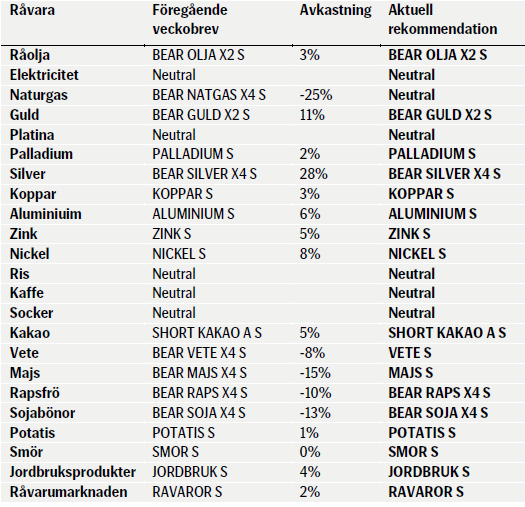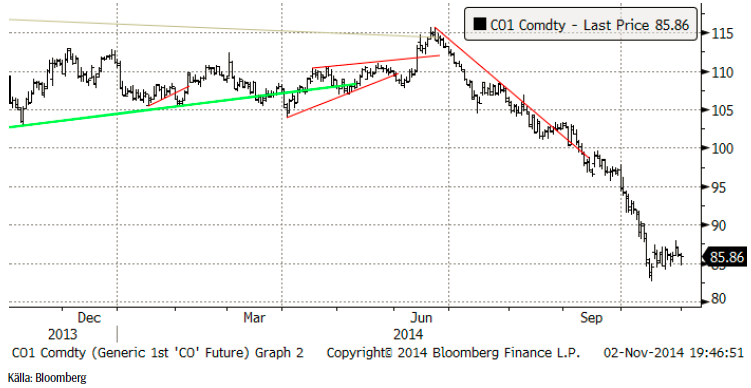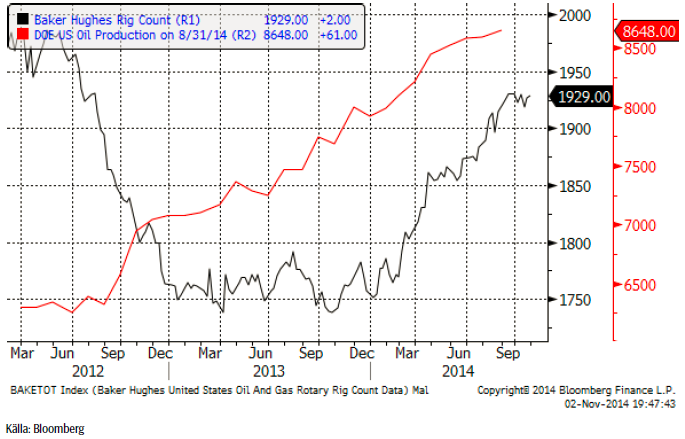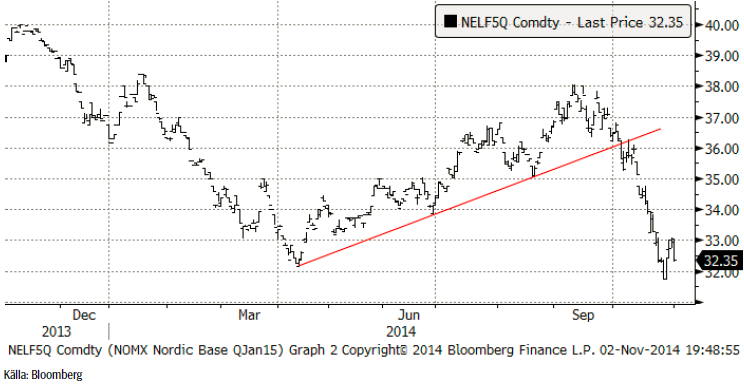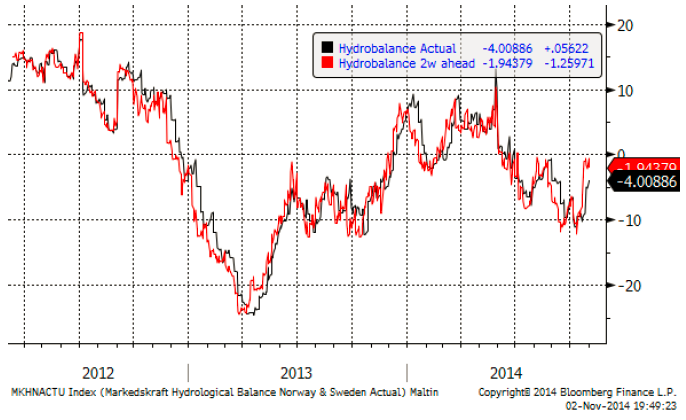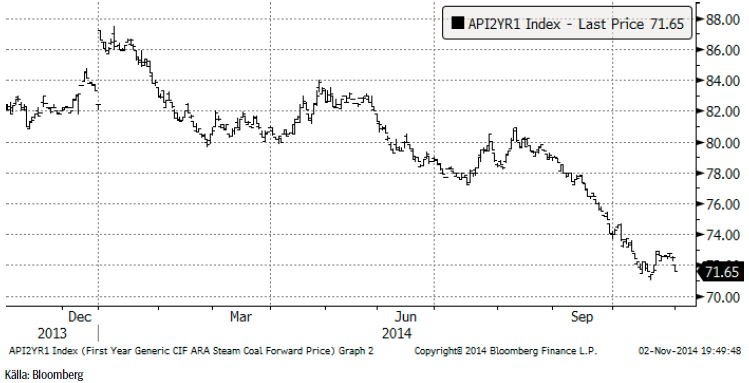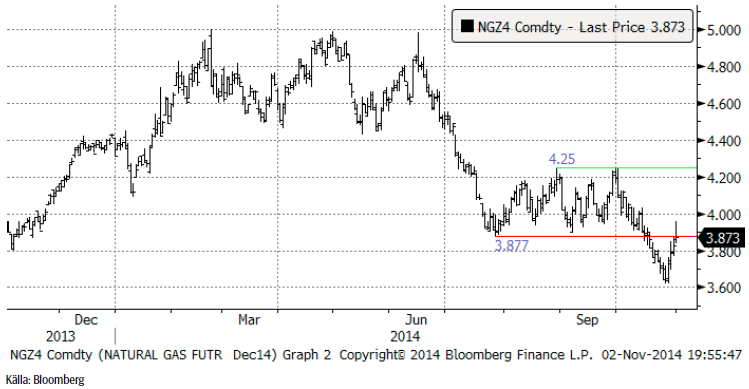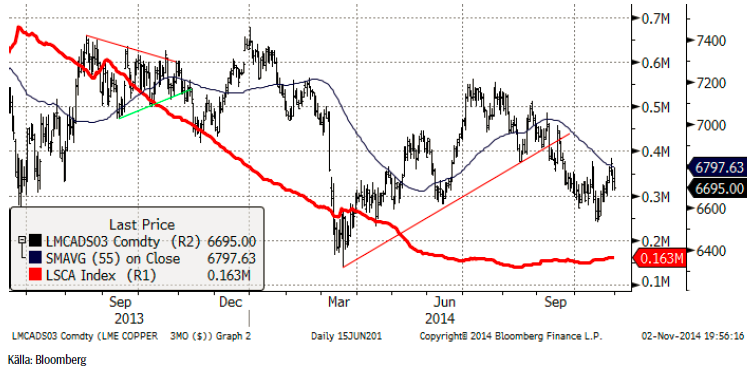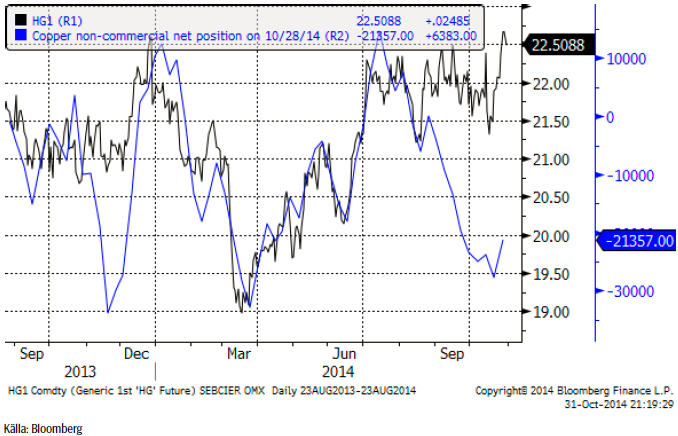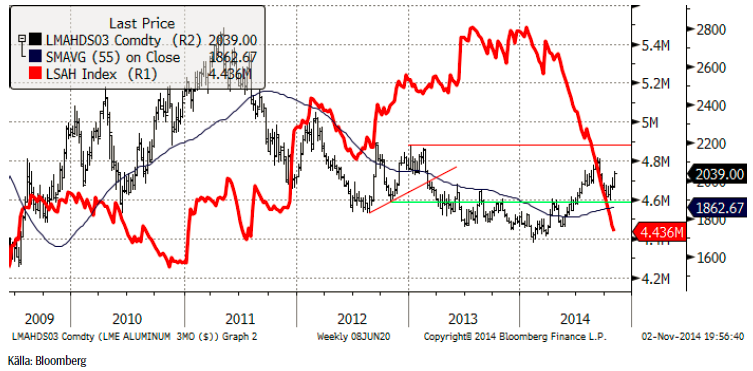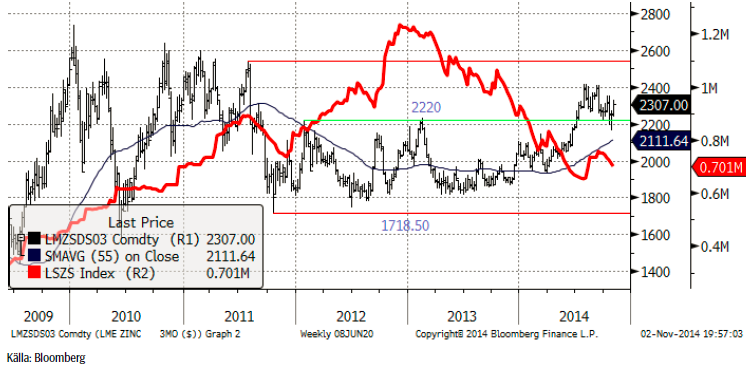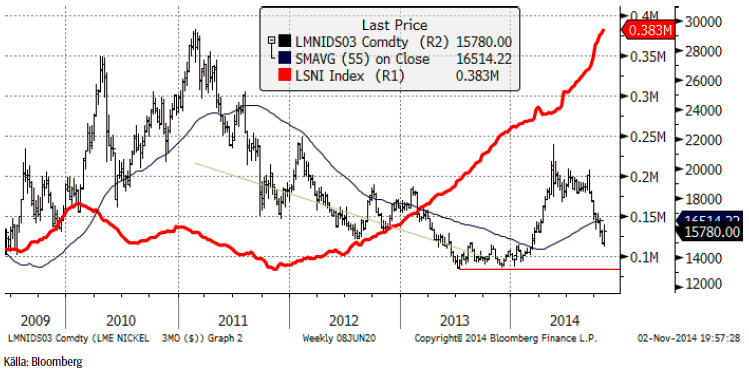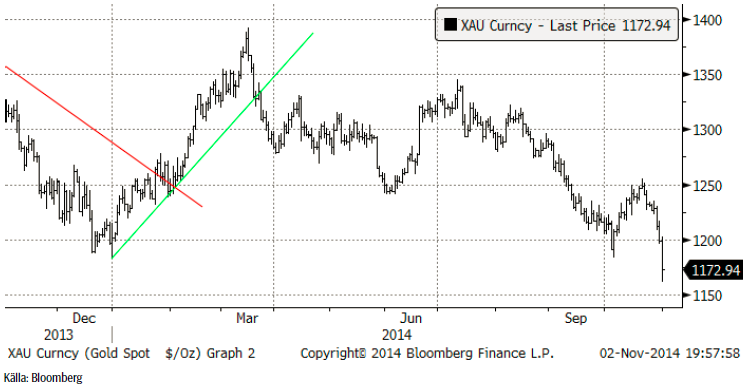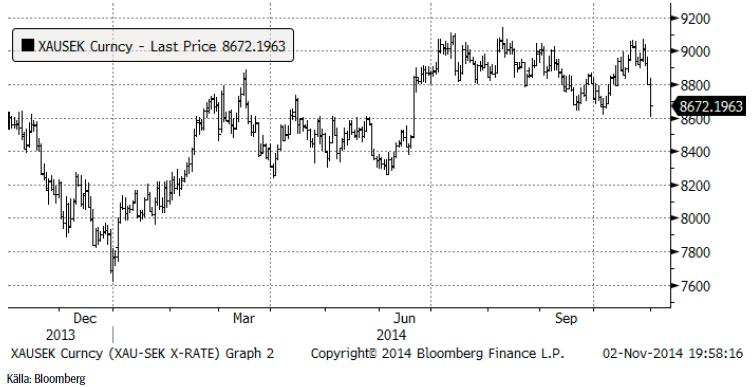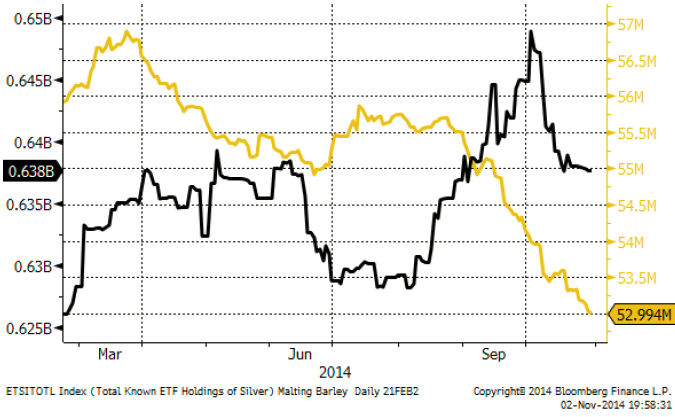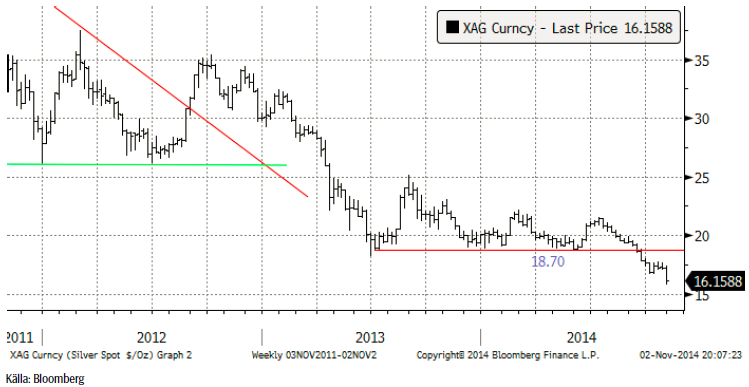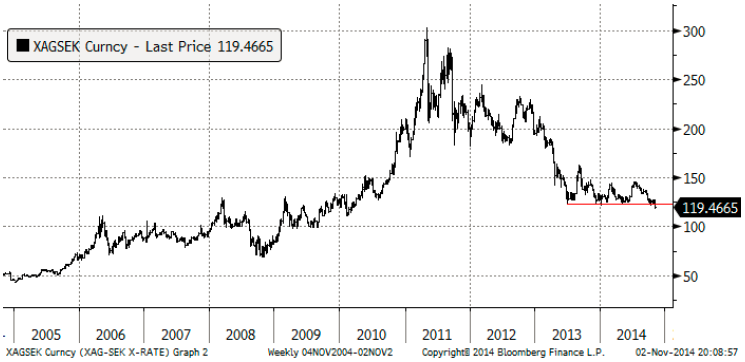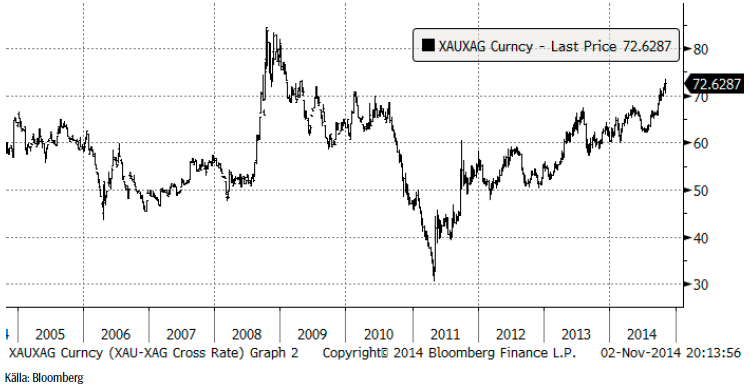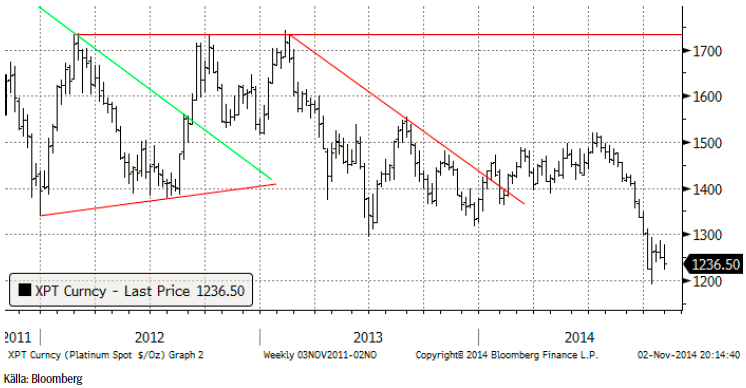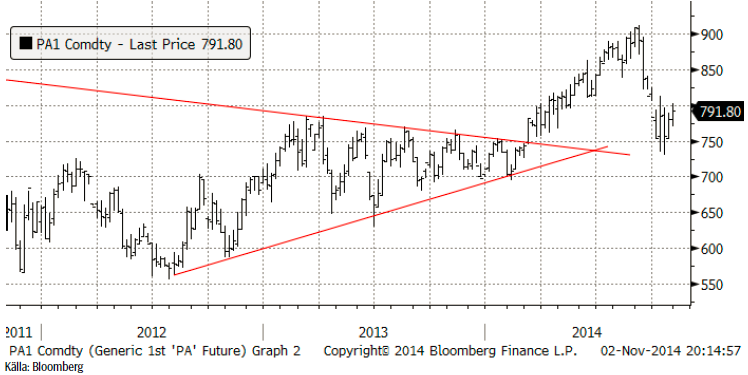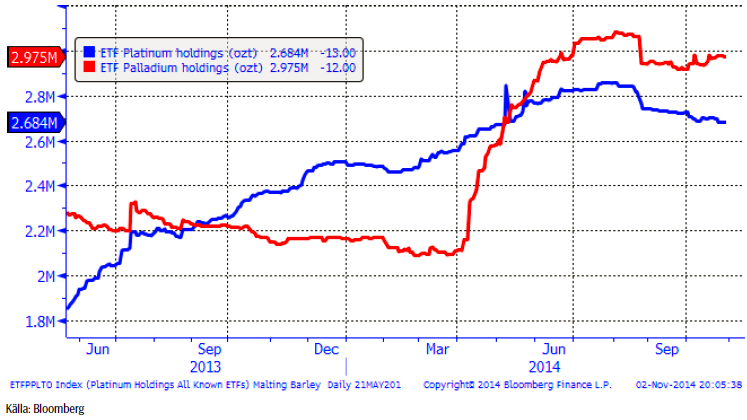Analys
SEB – Råvarukommentarer, 3 november 2014

Veckans rekommendationer
Råolja – Brent
Fredagens huvudnyhet på oljemarknaden var att OPEC producerade 31 mbpd i oktober, över sitt produktionstak på 30 mbpd. Det finns alltså inga tecken på att OPEC minskar utbudet. Lägg därtill en starkare dollar och att oljepriset fortsätter att handlas ner. Oljepriset har sjunkit den senaste veckan trots ökande tillväxtoptimism, högre BNP-tillväxt i USA än väntat och stimulans från Bank of Japan. Aktier och metaller har gått upp i pris på detta, men oljan fortsätter nedåt.
VD:n för det amerikanska bolaget Cheniere Energy sade i veckan att ”WTI kommer nästan helt säkert att falla till 50 – 60 dollar per fat. Kostnaderna för att producera amerikansk skifferolja är mycket lägre än vad många tror.”
Vi erfar att amerikansk skifferoljeproduktion är billigare än konventionell amerikansk olja. Amerikansk skifferolja kostar 58 dollar per fat medan konventionell kostar 60 dollar. Statoil sade i veckan att man inte kan förbli konkurrenskraftig som oljebolag om man inte producerar skifferolja.
Vi tror att det tar 6-12 månader för att bromsa tillväxten i amerikansk skifferoljeproduktion efter att priset har fallit till under break-even och det priset är inte uppnått än. Det finns dock ännu inte några tecken på att skifferoljeproduktionen tar fart på allvar utanför USA. Det beror huvudsakligen på att det saknas infrastruktur.
Förra veckan noterade vi att det sker en lageruppbyggnad i Saudiarabien därför att de faktiskt inte lyckas sälja all ökad produktion av olja. På global basis är detta mer betydelsefullt än man med de senaste årens erfarenhet av brist kan föreställa sig. Fortsätter produktionsökningen i USA på dagens nivå kommer det att vara ett produktionsöverskott på 2 mbpd nästa år om produktionen inte minskar. I den takten fylls alla tänkbara lagringsmöjligheter på sex månader.
Det finns dock även positiva tecken. Kina har tagit alla ”överskottslaster”. Västafrika höjde sina benchmarkpriser istället för att sänka dem, som Irak, Iran och Saudiarabien.
Nedan ser vi ett diagram på antalet oljeriggar i USA, enligt Baker Hughes statistik (svart). Antalet ökade med 2 från förra veckan.
Vi rekommenderar en kort position, t ex med BEAR OLJA X2 S.
Elektricitet
Priset på el studsade på 32 euro, där vi rekommenderade att ta hem vinster i förra veckans brev. Priset rekylerade till 33 euro, men föll i fredags återigen och stängde på 32.35. Det är möjligt att det kan komma en nytt test av stödet vid 32 euro.
Hydrologisk balans har enligt 2-veckors prognosen stigit till nästan normal nivå. Vädret väntas fortsatt att vara både varmt och nederbördsrikt.
Nedan ser vi terminspriset för kalenderåret 2015 avseende energikol. Priset rekylerade uppåt från 71 dollar för drygt en vecka sedan, men detta vände inte trenden. Efter lite sidledes rörelse föll priset ganska kraftigt i fredags och stängde på 71.65 dollar per ton. Ett nytt test av 71 dollarsnivån verkar vara inom räckhåll.
Vi rekommenderade förra veckan att ta hem vinsterna på den korta positionen. Tendensen i marknaden är dock fortsatt negativ. Skulle prisnivån 32 euro brytas, kan det vara aktuellt att gå kort igen.
Naturgas
Naturgaspriset (decemberkontraktet) startade en rekyl från 3.60, som tog priset upp till 3.873 i fredags (strax under motståndet 3.877), även om priset var högre under fredagen. Tekniskt borde priset gå ner och vi håller därför fast vid BEAR NATGAS X4 S.
Koppar
Med hög volatilitet handlades kopparpriset högre hela veckan. Från teknisk synvinkel, rekylerar priset den större, fallande pristrenden från början av året. Ur ett fundamentalt perspektiv är detta i linje med förväntningarna om att marknaden går från underskott till överskott. Enligt International Copper Study Group (ICSG) kommer år 2014 att uppvisa ett underskott på 307 kt, som vänds till ett överskott på 393 kt nästa år. Den här förändringen har ännu inte resulterat i en svagare marknad. Bristen på material på LME håller marknaden i ett hårt grepp. Cash till 3-månaders terminsnotering handlas i stadig backwardation på 60 – 70 dollar. Resten av terminskurvan uppvisar ungefär samma mönster. Den globala ekonomin har i någon mån stärkts den senaste tiden med mer stimulans och statistik från USA som visar att tillväxten är god. Säsongsmässigt är vi nu inne i det starkaste kvartalet. Vi behåller åsiken att det finns utsikter för högre pris på koppar resten av året.
Koppar är den enda basmetallen som handlas i USA och därför har vi tillgång till statistik på vad spekulantkollektivet gör där. Vi ser att de har sålt sig ganska korta sedan början av juli. Nettopositionen är 21,000 kontrakt. I den rapport som kom i fredags kväll och visade förändringen tisdag – tisdag, hade de köpt tillbaka 6000 kontrakt. En stor såld position kan när den täcks ge lite extra stöd för priset.
Vi håller fast vid vår rekommendation av KOPPAR S.
Aluminium
Det är intressant att notera att aluminiumtackor har återlämnats till LME mot lagerbevis (warrants) för första gången sedan det var backwardation senast, i augusti. Detta har noterats bland annat i lagerhuset i Vlissingen. Det noterades ett nettoinflöde även den 30 oktober. Inflödet är ett tecken på att aktörer drar nytta av den backwardation som finns i terminspriserna. De säljer spot och köper tillbaka på termin. Som vi har påpekat tidigare, ger de höga premierna (>500 dollar) i både USA och i EU, en anledning att vid något tillfälle sälja istället för att förnya finansieringsaffärerna.
Samtidigt som efterfrågan tar fart globalt, tror vi att aluminiummarknaden kommer att vara stark resten av året. Priset gick upp varje dag i veckan som gick. Det tekniska motståndet vid 2040-50 dollar var dock lite för svårt att byta igenom och vi såg tendenser till vinsthemtagningar framåt fredagens eftermiddag.
Vi fortsätter att rekommendera köp av ALUMINIUM S.
Zink
Skillnaden mellan cash och 3-månaders termin på zink handlades ner i backwardation i veckan och i fredags hade skillnaden hunnit bli 8 dollar. Längre ut på terminskurvan är det fortfarande contango. Utflödet av metall från LME sker huvudsakligen på ett enda ställa, New Orleans. Det anses tyda på att materialet bara flyttas till ett billigare lager (till finansieringsaffärer). Om metallen skulle gå till konsumtion, skulle man normalt se utflöden på fler ställen och i små enheter.
I motsats till aluminium, är den fysiska premien för zink inte förhöjd och den fysiska marknaden präglas inte av brist. Två teman har varit i fokus på zinkmarknaden i år. För det första verkar fonder och CTA:s gilla metallen, vilket beror på den positiva långsiktiga trenden som beror på gruvnedläggningar. De har handlat in och ut och hållit marknaden inom olika prisintervall. För det andra har uppsidan varit begränsad av prissäkring från gruvbolag. 2400 dollar verkar vara nivån. Vi har noterat den stadiga förbättringen av den fundamentala balansen, såsom rapporterat huvudsakligen av International Zink Study Group (ILZSG). Baserat på data därifrån förväntar vi oss ytterligare lagerminskningar och en stadigare positiv pristrend. Vår bedömning är att priset kommer att ligga i intervallet 2200 – 2350 dollar per ton under det fjärde kvartalet. Vi kan möjligen få se 2400 dollar (toppnoteringen från sommarmånaderna).
Vi rekommenderar köp av ZINK S.
Nickel
Veckan började på samma sätt som den gjort sedan den fallande pristrenden började i mitten av september, dvs svagt. Den viktiga tekniska stödnivån på 15,800 dollar testades och bröts, men inga stop-loss-ordrar eldade på prisfallet. På tisdagsmorgonen vände marknaden. En våg av ”short covering” tryckte upp priset ända till 15,650 senare på kvällen. Efter lite lugnare handel och konsolidering mitt i veckan, steg priset till veckans högsta nivå, 16,175 dollar på fredagen, innan vinsthemtagningar inför helgen tog överhanden och stängde marknaden strax under 16,000 dollar.
Det verkar som om marknadens aktörer vände fokus till den fundamentala situationen, och att det mesta av NPI-produktionen blir olönsam vid de här prisnivåerna på primärnickel. Om man beaktar den sämre filippinska malmen, som motsvarar en produktionskostnad på nickel på runt 20,000 dollar, verkar dagens nivå attraktiv. Vi hör talas om att långsiktiga investerare har börjat eller börjar utnyttja det låga priset som rekylen har gett upphov till, för att bygga en lång position. Tekniskt kan man säga att den branta rekylen något bröts av veckans handel och det ger i första hand en indikation på att man kan vänta sig ”sidledes” handel mellan 15,000 och 17,000 dollar per ton.
Vi tycker att de kommande veckorna kan ge möjlighet att komma in på den långa sidan och rekommenderar köp av NICKEL S.
Guld
Guldpriset har tagit stryk av tre anledningar: För det första har QE3 avslutats i USA. Det var i och för sig helt väntat att FED:s nedtrappning av obligationsköpen skulle sluta nu. Nedtrappningen inleddes veckan före jul för nu nästan ett år sedan och nådde sitt slut nu. Den andra faktorn, som pressar guldpriset är att när FED senast uttalade sig om räntan, föreföll det luta lite mer åt räntehöjningar än tidigare. Tillväxten i USA överraskar också på den positiva sidan. På grund av såväl lite mer positiva utsikter för räntehöjning, hög tillväxt och allmän oro i världen, fortsätter dollarn att stiga mot andra valutor – och mot guldet. Med andra ord sjunker priset på guld uttryckt i dollar.
Chartet för guld i kronor ligger kvar vid 8850 kronor per uns.
Investerare fortsätter att sälja av guldfonder och hittills i oktober även silverfonder.
Den ryska centralbanken fortsätter att köpa guld. Detta måste ses mot bakgrund av att den ryska rubeln har tappat 23% mot dollarn sedan månadsskiftet juni/ juli. Valutafallet hejdades temporärt i torsdags, men tog ny fart på fredagen och Rysslands köp av guld har i vart fall inte haft någon synlig effekt på svagheten i guldpriset.
Vi fortsätter med såld position i guld, t ex med BEAR GULD X2 S.
Silver
Silverpriset föll huvudsakligen i torsdags och i fredags och det var ett relativt kraftigt prisfall.
Silverpriset i svenska kronor har brutit stödet vid 123 kronor per uns. Nästa stöd finns nu vid 100 kr per uns, som agerade motstånd från 2006 och framåt och stöd från år 2009. Uppsidan är nu begränsad av 123 kr, som är det nya motståndet. Marknaden kommer att ha mycket svårt att ta sig över den nivån, med tanke på hur länge det fungerade som stöd.
Silver är fortsatt billigt i förhållande till guld och det kan vara en anledning att byta en investering i guld mot silver.
Vi fortsätter att på kort sikt rekommendera en kort position i silver med köp av BEAR SILVER X4 S.
Platina & Palladium
Både platina och palladium har befunnit sig i konsolideringsfas några veckor. I fredags verkade konsolideringen vara över för båda metallerna, men de ser ut att bryta ut åt olika håll. Medan platina föll kraftigt mot slutet av veckan, tillsammans med guld och silver, visade palladium styrka och verkar vara på väg att testa 900 dollar igen.
Palladium fick som väntat stöd vid 750 dollar. I veckan tog marknaden vad som kan vara det första steget uppåt för att kanske lämna den här rekylen nedåt och konsolideringen bakom sig. Nästa motstånd finns på 850 och därefter 900 dollar.
Nedanför ser vi hur mycket metall som finns i börshandlade fonder för platina respektive palladium. Investerare fortsätter att sälja av platina, men verkar behålla sitt palladium och till och med öka på den.
Vi fortsätter med neutral rekommendation på platina, men rekommenderar köp av palladium via t ex PALLADIUM S.
[box]SEB Veckobrev Veckans råvarukommentar är producerat av SEB Merchant Banking och publiceras i samarbete och med tillstånd på Råvarumarknaden.se[/box]
Disclaimer
The information in this document has been compiled by SEB Merchant Banking, a division within Skandinaviska Enskilda Banken AB (publ) (“SEB”).
Opinions contained in this report represent the bank’s present opinion only and are subject to change without notice. All information contained in this report has been compiled in good faith from sources believed to be reliable. However, no representation or warranty, expressed or implied, is made with respect to the completeness or accuracy of its contents and the information is not to be relied upon as authoritative. Anyone considering taking actions based upon the content of this document is urged to base his or her investment decisions upon such investigations as he or she deems necessary. This document is being provided as information only, and no specific actions are being solicited as a result of it; to the extent permitted by law, no liability whatsoever is accepted for any direct or consequential loss arising from use of this document or its contents.
About SEB
SEB is a public company incorporated in Stockholm, Sweden, with limited liability. It is a participant at major Nordic and other European Regulated Markets and Multilateral Trading Facilities (as well as some non-European equivalent markets) for trading in financial instruments, such as markets operated by NASDAQ OMX, NYSE Euronext, London Stock Exchange, Deutsche Börse, Swiss Exchanges, Turquoise and Chi-X. SEB is authorized and regulated by Finansinspektionen in Sweden; it is authorized and subject to limited regulation by the Financial Services Authority for the conduct of designated investment business in the UK, and is subject to the provisions of relevant regulators in all other jurisdictions where SEB conducts operations. SEB Merchant Banking. All rights reserved.
Analys
Tightening fundamentals – bullish inventories from DOE

The latest weekly report from the US DOE showed a substantial drawdown across key petroleum categories, adding more upside potential to the fundamental picture.

Commercial crude inventories (excl. SPR) fell by 5.8 million barrels, bringing total inventories down to 415.1 million barrels. Now sitting 11% below the five-year seasonal norm and placed in the lowest 2015-2022 range (see picture below).
Product inventories also tightened further last week. Gasoline inventories declined by 2.1 million barrels, with reductions seen in both finished gasoline and blending components. Current gasoline levels are about 3% below the five-year average for this time of year.
Among products, the most notable move came in diesel, where inventories dropped by almost 4.1 million barrels, deepening the deficit to around 20% below seasonal norms – continuing to underscore the persistent supply tightness in diesel markets.
The only area of inventory growth was in propane/propylene, which posted a significant 5.1-million-barrel build and now stands 9% above the five-year average.
Total commercial petroleum inventories (crude plus refined products) declined by 4.2 million barrels on the week, reinforcing the overall tightening of US crude and products.


Analys
Bombs to ”ceasefire” in hours – Brent below $70

A classic case of “buy the rumor, sell the news” played out in oil markets, as Brent crude has dropped sharply – down nearly USD 10 per barrel since yesterday evening – following Iran’s retaliatory strike on a U.S. air base in Qatar. The immediate reaction was: “That was it?” The strike followed a carefully calibrated, non-escalatory playbook, avoiding direct threats to energy infrastructure or disruption of shipping through the Strait of Hormuz – thus calming worst-case fears.

After Monday morning’s sharp spike to USD 81.4 per barrel, triggered by the U.S. bombing of Iranian nuclear facilities, oil prices drifted sideways in anticipation of a potential Iranian response. That response came with advance warning and caused limited physical damage. Early this morning, both the U.S. President and Iranian state media announced a ceasefire, effectively placing a lid on the immediate conflict risk – at least for now.
As a result, Brent crude has now fallen by a total of USD 12 from Monday’s peak, currently trading around USD 69 per barrel.
Looking beyond geopolitics, the market will now shift its focus to the upcoming OPEC+ meeting in early July. Saudi Arabia’s decision to increase output earlier this year – despite falling prices – has drawn renewed attention considering recent developments. Some suggest this was a response to U.S. pressure to offset potential Iranian supply losses.
However, consensus is that the move was driven more by internal OPEC+ dynamics. After years of curbing production to support prices, Riyadh had grown frustrated with quota-busting by several members (notably Kazakhstan). With Saudi Arabia cutting up to 2 million barrels per day – roughly 2% of global supply – returns were diminishing, and the risk of losing market share was rising. The production increase is widely seen as an effort to reassert leadership and restore discipline within the group.
That said, the FT recently stated that, the Saudis remain wary of past missteps. In 2018, Riyadh ramped up output at Trump’s request ahead of Iran sanctions, only to see prices collapse when the U.S. granted broad waivers – triggering oversupply. Officials have reportedly made it clear they don’t intend to repeat that mistake.
The recent visit by President Trump to Saudi Arabia, which included agreements on AI, defense, and nuclear cooperation, suggests a broader strategic alignment. This has fueled speculation about a quiet “pump-for-politics” deal behind recent production moves.
Looking ahead, oil prices have now retraced the entire rally sparked by the June 13 Israel–Iran escalation. This retreat provides more political and policy space for both the U.S. and Saudi Arabia. Specifically, it makes it easier for Riyadh to scale back its three recent production hikes of 411,000 barrels each, potentially returning to more moderate increases of 137,000 barrels for August and September.
In short: with no major loss of Iranian supply to the market, OPEC+ – led by Saudi Arabia – no longer needs to compensate for a disruption that hasn’t materialized, especially not to please the U.S. at the cost of its own market strategy. As the Saudis themselves have signaled, they are unlikely to repeat previous mistakes.
Conclusion: With Brent now in the high USD 60s, buying oil looks fundamentally justified. The geopolitical premium has deflated, but tensions between Israel and Iran remain unresolved – and the risk of missteps and renewed escalation still lingers. In fact, even this morning, reports have emerged of renewed missile fire despite the declared “truce.” The path forward may be calmer – but it is far from stable.
Analys
A muted price reaction. Market looks relaxed, but it is still on edge waiting for what Iran will do

Brent crossed the 80-line this morning but quickly fell back assigning limited probability for Iran choosing to close the Strait of Hormuz. Brent traded in a range of USD 70.56 – 79.04/b last week as the market fluctuated between ”Iran wants a deal” and ”US is about to attack Iran”. At the end of the week though, Donald Trump managed to convince markets (and probably also Iran) that he would make a decision within two weeks. I.e. no imminent attack. Previously when when he has talked about ”making a decision within two weeks” he has often ended up doing nothing in the end. The oil market relaxed as a result and the week ended at USD 77.01/b which is just USD 6/b above the year to date average of USD 71/b.

Brent jumped to USD 81.4/b this morning, the highest since mid-January, but then quickly fell back to a current price of USD 78.2/b which is only up 1.5% versus the close on Friday. As such the market is pricing a fairly low probability that Iran will actually close the Strait of Hormuz. Probably because it will hurt Iranian oil exports as well as the global oil market.
It was however all smoke and mirrors. Deception. The US attacked Iran on Saturday. The attack involved 125 warplanes, submarines and surface warships and 14 bunker buster bombs were dropped on Iranian nuclear sites including Fordow, Natanz and Isfahan. In response the Iranian Parliament voted in support of closing the Strait of Hormuz where some 17 mb of crude and products is transported to the global market every day plus significant volumes of LNG. This is however merely an advise to the Supreme leader Ayatollah Ali Khamenei and the Supreme National Security Council which sits with the final and actual decision.
No supply of oil is lost yet. It is about the risk of Iran closing the Strait of Hormuz or not. So far not a single drop of oil supply has been lost to the global market. The price at the moment is all about the assessed risk of loss of supply. Will Iran choose to choke of the Strait of Hormuz or not? That is the big question. It would be painful for US consumers, for Donald Trump’s voter base, for the global economy but also for Iran and its population which relies on oil exports and income from selling oil out of that Strait as well. As such it is not a no-brainer choice for Iran to close the Strait for oil exports. And looking at the il price this morning it is clear that the oil market doesn’t assign a very high probability of it happening. It is however probably well within the capability of Iran to close the Strait off with rockets, mines, air-drones and possibly sea-drones. Just look at how Ukraine has been able to control and damage the Russian Black Sea fleet.
What to do about the highly enriched uranium which has gone missing? While the US and Israel can celebrate their destruction of Iranian nuclear facilities they are also scratching their heads over what to do with the lost Iranian nuclear material. Iran had 408 kg of highly enriched uranium (IAEA). Almost weapons grade. Enough for some 10 nuclear warheads. It seems to have been transported out of Fordow before the attack this weekend.
The market is still on edge. USD 80-something/b seems sensible while we wait. The oil market reaction to this weekend’s events is very muted so far. The market is still on edge awaiting what Iran will do. Because Iran will do something. But what and when? An oil price of 80-something seems like a sensible level until something do happen.
-

 Nyheter3 veckor sedan
Nyheter3 veckor sedanMahvie Minerals växlar spår – satsar fullt ut på guld
-

 Nyheter4 veckor sedan
Nyheter4 veckor sedanUppgången i oljepriset planade ut under helgen
-

 Nyheter4 veckor sedan
Nyheter4 veckor sedanLåga elpriser i sommar – men mellersta Sverige får en ökning
-

 Analys3 veckor sedan
Analys3 veckor sedanA muted price reaction. Market looks relaxed, but it is still on edge waiting for what Iran will do
-

 Nyheter3 veckor sedan
Nyheter3 veckor sedanJonas Lindvall är tillbaka med ett nytt oljebolag, Perthro, som ska börsnoteras
-

 Nyheter3 veckor sedan
Nyheter3 veckor sedanOljan, guldet och marknadens oroande tystnad
-

 Analys4 veckor sedan
Analys4 veckor sedanVery relaxed at USD 75/b. Risk barometer will likely fluctuate to higher levels with Brent into the 80ies or higher coming 2-3 weeks
-

 Nyheter3 veckor sedan
Nyheter3 veckor sedanDomstolen ger klartecken till Lappland Guldprospektering


